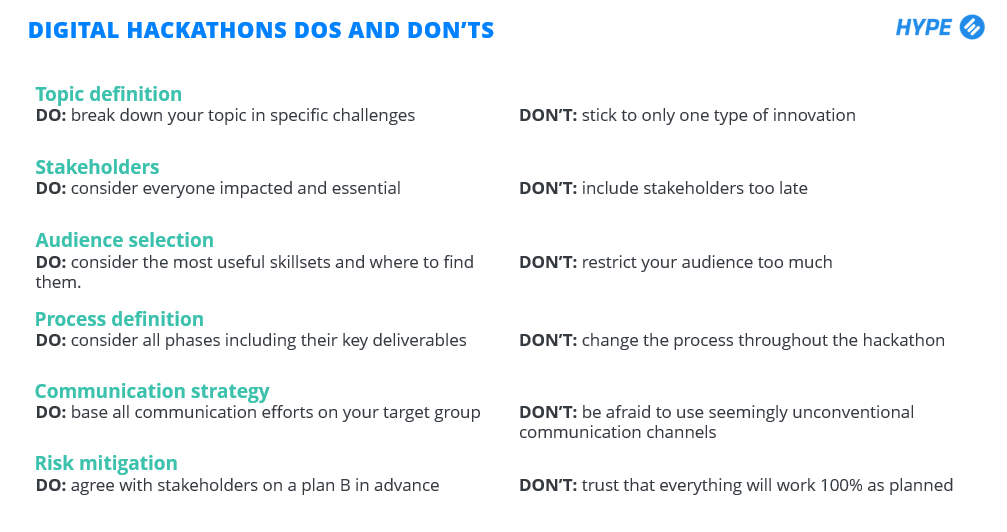Take two seemingly unrelated words, "hack" and "marathon," and put them together to describe one of the most popular and powerful problem-solving techniques in the past decade.
to hack \ ˈhak \
transitive verb
1: to cut or sever with repeated irregular or unskillful blows
2: to gain illegal access to (a computer network, system, etc.)
marathon \ ˈmer-ə-ˌthän \
noun
1: a footrace run on an open course usually of 26 miles / 42.2 kilometers
broadly: a long-distance race
2: a: an endurance contest
b: something (such as an event, activity, or session) characterized by great length or concentrated effort
Source: Merriam-Webster
Yes, "hack" and "marathon" can, and do, relate in many ways. As physical and digital interconnectedness rises, computing speed increases, and society's challenges grow ever more complex, organizing short, focused ideation sessions that attract top technical and non-technical talent and result in viable prototypes has become the new norm. This is, in simple terms, the power of the hackathon.
In this blog post, we will explore what a hackathon is, why hackathons are so popular, and how to run a hackathon successfully.
What Is a Hackathon?
We associate most hackathons today with software developers and hungry entrepreneurs, but organizations everywhere are using hackathons to solve challenges. Look around you, and you are bound to spot competitions in music, fashion, dance, architecture, and other disciplines to create a project in a short amount of time.
Depending on your industry and goal, hackathon setups can vary. For example, the Prada Group and German online retailer Zalando run hack-style events to tackle sustainability strategies. The Vatican (yes, the Vatican) sponsors events to find technological solutions for complex challenges such as creating social inclusion, promoting interfaith dialogue, and providing resources to migrants and refugees.
While each competition's purpose differs, the setup is mostly the same: a physical or digital event where participants are challenged to generate some form of innovation such as a functioning software or a hardware prototype.

What Makes Hackathons So Appealing?
So what do all these events have in common? And what has made them so popular? The answer seems to be in the so-called "hackathon culture" they promote.
Hacker culture was established in the 1960s by the original hackers who were members of MIT's Tech Model Railroad Club. This group promoted the idea of programming as a craft as opposed to a hobby or job. There was a deep sense of community in the projects, meaning that participants believed that working collectively was the way forward (this same type of thinking lies at the core of ecosystem-style collaborations).
According to independent tech media site Hackernoon, the hackathon is "so prolific and successful because it has become an autotelic, liberal, and great production measure for people interested in building technological projects, commonly using coding practices to do so." Of course, today, hackathons are helping build many non-technological projects and solutions, too.
In other words, hackathons allow for creative work, which is sometimes an end in itself. They are free from the typical constraints of developing something new (no need to adhere to a specific strategy, you can work with whomever you want – the sky's the limit). This liberating experience tends to create a sense of community among like-minded enthusiasts. "Anyone who has an interest in technology attends a hackathon to learn, build, and share his or her creations over the course of a weekend in a relaxed and welcoming atmosphere," writes Hackernoon.

While hackathons were initially organized as internal events, most organizations now open their hackathons to anyone who wants to contribute, including external participants. Experts with different backgrounds can help in addressing various topics – not just the technical ones.
Some critics have noted that corporate-sponsored hackathons are at odds with the initial purpose and identity of such events. They argue that prizes and flashiness might "constrain" the creative process and possibly attract the wrong types of participants. However, putting the needs of the participants ("the hackers") before those of the organizers provides a simple solution.
Today, the most successful hackathons build on the notion that solutions for the people, by the people, can have an immense impact.
How to Run a Hackathon?
Running a successful hackathon is chiefly about a robust and well-formulated challenge, an engaged crowd, and securing the right infrastructure.
Whether digital or physical, every hackathon follows roughly the same process: preparation, team creation, creative problem solving, and, finally, presentations and awards. Below, we break down the steps. Before the hackathon:
1. Choose a motto and define the challenge(s)
All hackathons are theme-based, so choosing a theme that will attract the right crowd is vital.
Internal preparations – e.g., briefings with teams that would like to contribute to challenges – should start as early as possible. It is especially important to brief all organizers and relevant stakeholders thoroughly and to check for any significant constraints that might influence the hackathons, like working laws or overlap with other events.
The challenge itself (the more specific need or set of requirements associated with the motto) can be declared before the hackathon starts or on the spot. Participants should understand the question thoroughly. If they are required to fill out a canvas or work with a particular template, they must have time to ask clarifying questions before the actual work begins.
2. Decide on the right infrastructure
You can run a hackathon in a physical or digital space. Both have advantages and disadvantages. A physical space will often let participants connect faster on a personal level, use materials such as Post-Its, and allow for tangible rewards such as prizes or gifts at the end.
Digital spaces enable you to invite anyone from anywhere in the world. This includes participants but also experts, mentors, and jury members. The diversity is, therefore, much higher, leading to creative output. A digital space such as a platform where teams can form and where creativity can flourish will enable you to collaborate and co-create even during a pandemic.
3. Define your process
When defining your process, think about which phases your participants should go through. With each of these phases, you will then associate key deliverables that participants will work on. The main deliverable at the end of the hackathon will be a pitch. Many participants have never pitched in their lives. What guidance can you give them? What should they watch out for or mention? How much time will they get? Answering all of these questions will ensure a high quality of the results you will see.
When defining the process, a crucial decision will also be whether all ideas go through all steps, resulting in one or multiple winners, or whether to include evaluations/gates in between that filter ideas out. Don't just consider the hackathon itself but also what will happen with ideas afterward.
4. Define and communicate to your key stakeholders
Identify and onboard key stakeholders as soon as possible. Stakeholders are the people who will be impacted by the results, who will support your efforts, or even sponsor a challenge or the entire hackathon. Some of your stakeholders might be involved in the implementation of specific ideas.
One of your key stakeholders should be from your legal department due to the potential of creating intellectual property. We recommend having the IP discussion early and drafting appropriate terms and conditions. With most hackathons, the organizers will not own the outcomes, and it is essential to clarify whether this is so.
However, even with idea submitters and teams owning IP, there are still plenty of opportunities for organizations to work with them. Often, IP is not created during the actual hackathon but rather later when incubating the prototypes created during the hackathon.
5. Roles & responsibilities
A hackathon requires some roles and stakeholders to take on responsibilities. Here is a quick overview:
- Organizational team: takes care of all administrative things and tracks the progress of the hackathon.
- Sponsors: are the head of each challenge. The better known they are, the better for the success of the hackathon. Ideally, sponsors will provide videos to explain the challenges in more detail and consequently make them more tangible. Sponsors might be included in the implementation afterward.
- Evaluators: make up a jury that evaluates ideas and teams during the hackathon. At a minimum, they are evaluating pitches at the end. It also helps to have known people in this role as it establishes the hackathon's credibility.
- Mentors: help participants throughout the hackathon and are vital to participants' success. In an online setting, mentors can be technical and business experts from anywhere in the world. They can be assigned to specific ideas and carefully follow the progress of each of their assigned teams. Video-call platforms like Zoom can help mentors communicate if the hackathon is not in-person.
- Participants: are the heart of the hackathon; they make it come alive. In a digital hackathon, people can join from anywhere.
6. Define your audience
When defining your audience, think about your topic and your challenges. Then consider who could solve them and what skillsets these participants would consequently need to have. You can make your hackathon more or less restricted – can anyone join, or do they need to fulfill specific criteria? Don't be afraid to go beyond your organization.
User management is also important. For physical hackathons, companies will need to use online event tools like Eventbrite. This way, the event is official, and registration confirmation is nearly immediate. For online hackathons, use the same software used for registration to submit the solution.
7. Consider risks and obstacles
Every project has the potential to go wrong, but the time-critical aspect of hackathons adds complexity. To give yourself and your stakeholders some relief, compile a list in advance that outlines different risks and how you would mitigate them. For example, if you're doing an online hackathon and your participants' internet connection is spotty, they won't be able to deliver on time. How much additional time would you want to give them? How would that work in the process that follows?

During the hackathon:
8. Matchmaking: Share skills and create teams
You might want to match participants according to their skills, helping them build strong teams. In most cases, groups will develop before the hackathon begins. Teams forming ahead of time ensures there's cohesion among team members and that they can start working on the challenge as soon as the hackathon kicks off.
Especially in an online environment, there are often too many participants for organizers to team up. In these cases, using a hackathon platform can help by showing relevant skill sets to idea owners and related ideas to interested participants.
9. The 'hack'
If we take the "hack" out of the hackathon, the "marathon" aspect remains and is the heart of what this event is: an opportunity to document and demonstrate a solution rapidly. During the live phase of the hackathon, teams will concentrate on outlining their proposal, designing and offering an initial prototype, and attractively describing this solution. For example, they will build a prototype, create a slide deck, and rehearse a pitch.
To help them through this, some hackathon organizers nominate free-floating experts who provide coaching and mentoring. Mentors have the most important role in the entire process. They are vital to the process since many participants have never built a prototype or a business model. For online hackathons, mentors can periodically check in with teams to monitor progress and offer support. Mentors make or break the hackathon's success, so make sure to choose them wisely. Have a diverse range of mentors ready to support participants with whatever they might need. In an online hackathon, take advantage of the fact that mentors could be anywhere in the world.
10. Communication throughout the hack
As the team organizing the hackathon, you might think the hard work is over once the hackathon starts; you just sit back and watch the participants create, right? If only it were that easy. In reality, you'll be busy helping participants with unforeseen challenges, motivating (or replacing) mentors, and, most importantly, communicating at all times.
Remember that reminders should be frequent and informative, especially in an online setting where it can be challenging to keep the momentum. Make sure to send reminders through communication channels that your audience uses. With a more formal audience, think email. In a less formal environment, use other means such as WhatsApp text chains, regular text messages, or social media. A software platform can also help with communication since participants are already in that environment.
After the hackathon:
11. Judging ideas
Make sure to communicate the judging criteria to the jury. Without this, the jury won't agree on the winners. A diverse, but also prominent jury can attract more participants if they know about them in advance. With an online hackathon, you have the choice to let jury members evaluate individually and as a team. There is less group bias when judging individually. A system would then automatically rank the ideas according to the jury's opinions.
12. Announce the winners
Once the live hackathon has concluded, participants will deliver their pitches/presentations (typical duration is 8 to 10 minutes, including questions). Here, the team should present their concept and ideally show a prototype. Next, a jury will take time to deliberate, and, finally, announce the winners.
Rewards in hackathons can be diverse. They include cash prizes, goodie bags (containing treats, books, or various vouchers), opportunities for further development (personal development or development of ideas), opportunities to have meetings with top-level executives, and even job offer proposals. The rewards need to be consistent with the nature of the challenge and the hackathon's motto. For example, if a hackathon revolves around sustainability, physical objects should be avoided.
You can include your audience in voting for their favorite project/team. A jury can vote based on criteria, and the audience can vote for the people's choice award, best pitch, or simply most liked. Allowing your audience to vote is an excellent way to pull people back in and create more participation toward the end of the hackathon.
13. Keep in touch
Make sure to follow through with winning ideas in whichever way you decide beforehand. Following through could mean incubating them now, developing them further internally, or having participants work on them further while staying in touch with you.
Hackathon participants are often very intrinsically motivated. No matter if they come from inside or outside your organization, it's worth staying in touch. For internal people, you can ask them to join innovation teams down the road. You might even decide to recruit external participants as employees or partner with them at a later date.
Additional Tips
- Don't let new information trickle in on the fly – the rules of the hackathon and the descriptions of the challenges should be final. Changing the rules of the game while participants are "playing" can lead to frustration, disappointment, and even withdrawal from the event.
- In digital hackathons, uploading the pitch deck or pitch videos takes time. Editing these materials also takes time. It's crucial to give participants enough time to do this.
- Focusing specifically on digital hackathons, below are some dos & don'ts:
 Summary
Summary
To sum up, hackathons represent an interactive form of collaboration that is, undoubtedly, here to stay.
While hackathons have some drawbacks (for example, participants might feel a diminishing return on long hours spent creating solutions), their impact is powerful and lasting. The culture of sharing they promote, the variety of talent they attract, their gamified, fun nature, and their versatility (run online and off, within or across organizations, etc.,) make hackathons an ideal tool for innovation.
HYPE Innovation helps organizations of all kinds run online hackathons. If you're interested in learning more about our hackathon platform and services, please get in touch.
End note: Oana-Maria Pop co-authored this blog article. Big thanks to Andreas Schindler and his hackathon teams at the Innovation Centre in Darmstadt for helping us understand the art and science of running a hackathon.











